
The development of television was the result of work by many inventors. Among them, Baird was a prominent pioneer and made major advances in the field. Particularly in Britain, many historians credit Baird with being the first to produce a live, moving, greyscale television image from reflected light. Baird achieved this, where other inventors had failed, by obtaining a better photoelectric cell and improving the signal conditioning from the photocell and the video amplifier.
The development of television was the result of work by many inventors. Among them, Baird was a prominent pioneer and made major advances in the field. Particularly in Britain, many historians credit Baird with being the first to produce a live, moving, greyscale television image from reflected light. Baird achieved this, where other inventors had failed, by obtaining a better photoelectric cell and improving the signal conditioning from the photocell and the video amplifier.
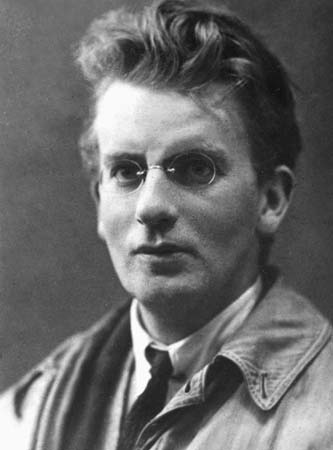

Between 1902 and 1907, Arthur Korn invented and built the first successful signal-conditioning circuits for image transmission. The circuits overcame the image-destroying lag effect that is part of selenium photocells. Korn's compensation circuit allowed him to send still pictures by telephone or wireless between countries and even over oceans, while his circuit operated without benefit of electronic amplification.[7] Korn's success at transmitting halftone still images suggested that such compensation circuits might work in television. Baird was the direct beneficiary of Korn's research and success.[8][9]
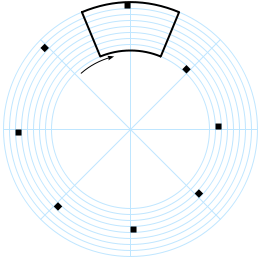
In his first attempts to develop a working television system, Baird experimented with the Nipkow disk. Paul Nipkow had invented this scanning disc system in 1884.[10] Television historian Albert Abramson calls Nipkow's patent "the master television patent".[11] Nipkow's work is important because Baird and many others chose to develop it into a broadcast medium.


In early 1923, and in poor health, Baird moved to 21 Linton Crescent, Hastings, on the south coast of England and later rented a workshop in Queen's Arcade in the town. Baird built what was to become the world's first working television set using items including an old hatbox and a pair of scissors, some darning needles, a few bicycle light lenses, a used tea chest, and sealing wax and glue that he purchased.[12] In February 1924, he demonstrated to the Radio Times that a semi-mechanical analogue television system was possible by transmitting moving silhouette images. In July of the same year, he received a 1000-volt electric shock, but survived with only a burnt hand. His landlord, Mr Tree, asked him to quit his workshop and he moved to upstairs rooms in Soho, London, where he made a technical breakthrough. Baird gave the first public demonstration of moving silhouette images by television at Selfridges department store in London in a three-week series of demonstrations beginning on 25 March 1925.

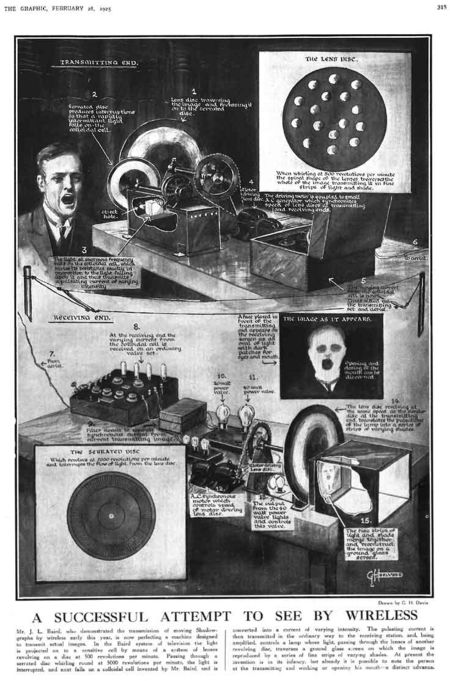
In his laboratory on 2 October 1925, Baird successfully transmitted the first television picture with a greyscale image: the head of a ventriloquist's dummy nicknamed "Stooky Bill" in a 30-line vertically scanned image, at five pictures per second.[13] Baird went downstairs and fetched an office worker, 20-year-old William Edward Taynton, to see what a human face would look like, and Taynton became the first person to be televised in a full tonal range.[14] Looking for publicity, Baird visited the Daily Express newspaper to promote his invention. The news editor was terrified: he was quoted by one of his staff as saying: "For God's sake, go down to reception and get rid of a lunatic who's down there. He says he's got a machine for seeing by wireless! Watch him — he may have a razor on him."[15]
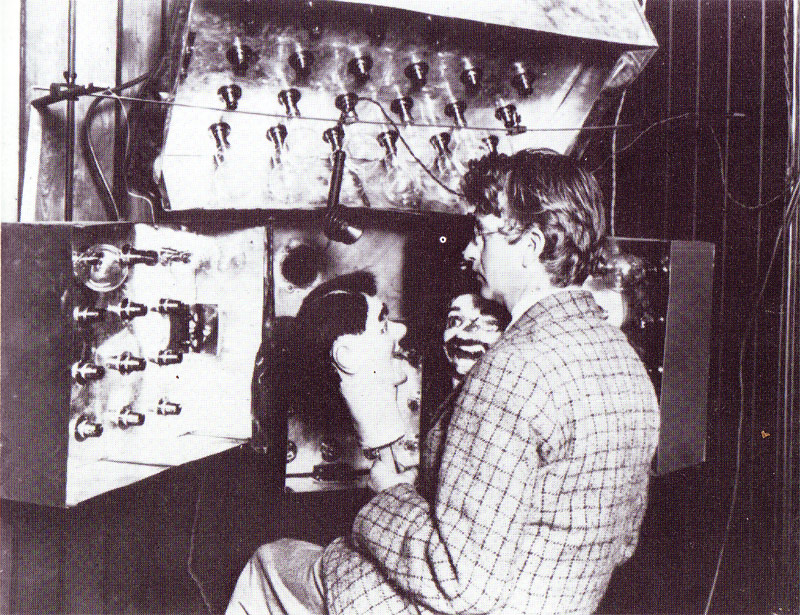

First public demonstrations
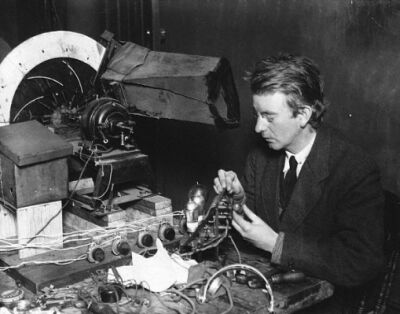
On 26 January 1926, Baird repeated the transmission for members of the Royal Institution and a reporter from The Times in his laboratory at 22 Frith Street in the Soho district of London.[16] By this time, he had improved the scan rate to 12.5 pictures per second. It was the first demonstration of a television system that could broadcast live moving images with tone graduation.

He demonstrated the world's first colour transmission on 3 July 1928, using scanning discs at the transmitting and receiving ends with three spirals of apertures, each spiral with a filter of a different primary colour; and three light sources at the receiving end, with a commutator to alternate their illumination.[17] That same year he also demonstrated stereoscopic television.[18]
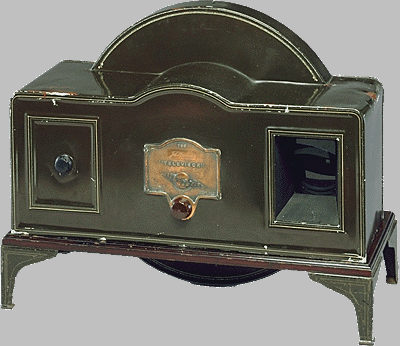
In 1932, Baird was the first person in Britain to demonstrate ultra-short wave transmission. (Today, we refer to "ultra short waves" as the VHF band.) Contrary to some reports, these transmissions were far from the first VHF telecasts. In 1931, the US Federal Radio Commission allocated VHF television bands. From 1931 to 1933, station W9XD in Milwaukee, Wisconsin, transmitted some of the first VHF television signals. The station's 45-line, triply interlaced pictures used the U. A. Sanabria television technology.[19]
Broadcasting

In 1927, Baird transmitted a long-distance television signal over 438 miles (705 km) of telephone line between London and Glasgow; Baird transmitted the world's first long-distance television pictures to the Central Hotel at Glasgow Central Station.[20] This transmission was Baird's response to a 225-mile, long-distance telecast between stations of AT&T Bell Labs. The Bell stations were in New York and Washington, DC. The earlier telecast took place in April 1927, a month before Baird's demonstration.[11]
Baird then set up the Baird Television Development Company Ltd, which in 1928 made the first transatlantic television transmission, from London to Hartsdale, New York, and the first television programme for the BBC. In November 1929, Baird and Bernard Natan established France's first television company, Télévision-Baird-Natan. He televised the first live transmission of the Epsom Derby in 1931. He demonstrated a theatre television system, with a screen two feet by five feet (60 cm by 150 cm), in 1930 at the London Coliseum, Berlin, Paris, and Stockholm.[21] By 1939 he had improved his theatre projection system to televise a boxing match on a screen 15 ft (4.6 m) by 12 ft (3.7 m).[22]

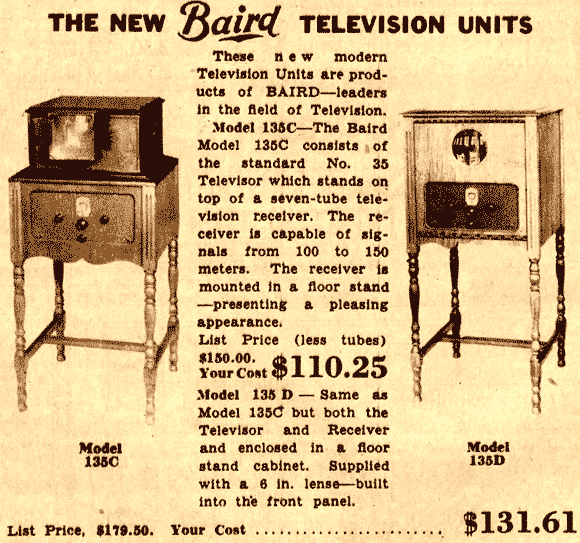
From 1929 to 1932, the BBC transmitters were used to broadcast television programmes using the 30-line Baird system, and from 1932 to 1935, the BBC also produced the programmes in their own studio at 16 Portland Place. On 3 November 1936, from Alexandra Palace located on the high ground of the north London ridge, the BBC began alternating Baird 240-line transmissions with EMI's electronic scanning system which had recently been improved to 405 lines after a merger with Marconi. The Baird system at the time involved an intermediate film process, where footage was shot on cinefilm which was rapidly developed and scanned. The trial was due to last 6 months but the BBC ceased broadcasts with the Baird system in February 1937, due in part to a disastrous fire in the Baird facilities at Crystal Palace. It was becoming apparent to the BBC that the Baird system would ultimately fail due in large part to the lack of mobility of the Baird system's cameras, with their developer tanks, hoses, and cables.[23]
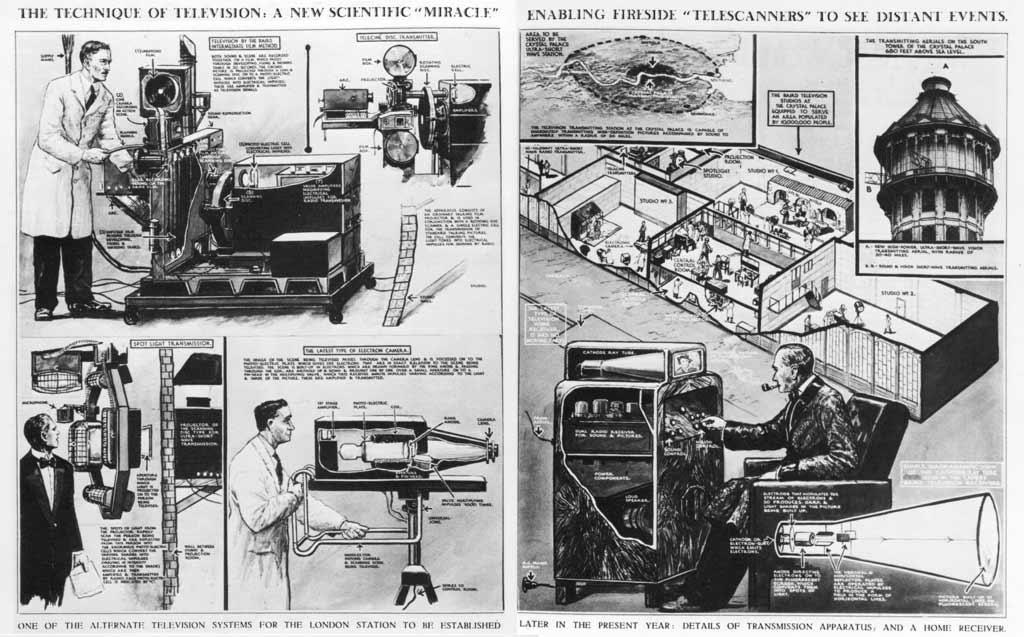
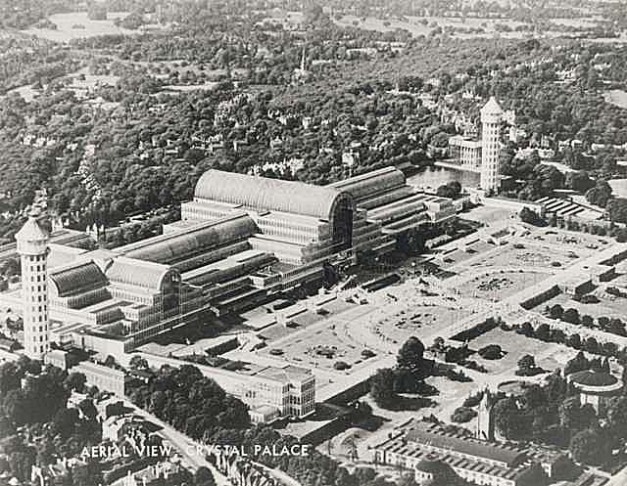
Baird's television systems were replaced by the electronic television system developed by the newly formed company EMI-Marconi under Isaac Shoenberg, which had access to patents developed by Vladimir Zworykin and RCA. Similarly, Philo T. Farnsworth's electronic "Image Dissector" camera was available to Baird's company via a patent-sharing agreement. However, the Image Dissector camera was found to be lacking in light sensitivity, requiring excessive levels of illumination. Baird used the Farnsworth tubes instead to scan cinefilm, in which capacity they proved serviceable though prone to dropouts and other problems. Farnsworth himself came to London to Baird's Crystal Palace laboratories in 1936, but was unable to fully solve the problem; the fire that burned Crystal Palace to the ground later that year further hampered the Baird company's ability to compete.[24]
Baird made many contributions to the field of electronic television after mechanical systems had taken a back seat. In 1939, he showed colour television using a cathode ray tube in front of which revolved a disc fitted with colour filters, a method taken up by CBS and RCA in the United States. In 1941, he patented and demonstrated a system of three-dimensional television at a definition of 500 lines. On 16 August 1944, he gave the world's first demonstration of a fully electronic colour television display. His 600-line colour system used triple interlacing, using six scans to build each picture.[25][26]

In 1943, the Hankey Committee was appointed to oversee the resumption of television broadcasts after the war. Baird persuaded them to make plans to adopt his proposed 1000-line Telechrome electronic colour system as the new post-war broadcast standard. The picture quality on this system would have been comparable to today's HDTV (High Definition Television). The Hankey Committee's plan lost all momentum partly due to the challenges of postwar reconstruction. The monochrome 405-line standard remained in place until 1985 in some areas, and it was three decades until the introduction of the 625-line system in 1964 and (PAL) colour in 1967. A demonstration of large screen three-dimensional television by the BBC was reported in March 2008, over 60 years after Baird's demonstration.

Other inventions
Some of Baird's early inventions were not fully successful. In his twenties he tried to create diamonds by heating graphite and shorted out Glasgow's electricity supply. Later Baird invented a glass razor which was rust-resistant, but shattered. Inspired by pneumatic tyres he attempted to make pneumatic shoes, but his prototype contained semi-inflated balloons which burst. He also invented a thermal undersock (the Baird undersock), which was moderately successful. Baird suffered from cold feet, and after a number of trials, he found that an extra layer of cotton inside the sock provided warmth.[12]
Baird's numerous other developments demonstrated his particular talent at invention. He was a visionary and began to dabble with electricity. In 1928, he developed an early video recording device, which he dubbed Phonovision. The system consisted of a large Nipkow disk attached by a mechanical linkage to a conventional 78-rpm record-cutting lathe. The result was a disc that could record and play back a 30-line video signal. Technical difficulties with the system prevented its further development, but some of the original phonodiscs have been preserved, and have since been restored by Donald McLean, a Scottish electrical engineer.[27]
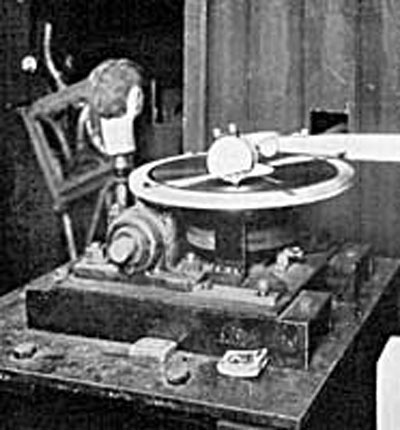

Baird's other developments were in fibre-optics, radio direction finding, infrared night viewing and radar. There is discussion about his exact contribution to the development of radar, for his wartime defence projects have never been officially acknowledged by the UK government. According to Malcolm Baird, his son, what is known is that in 1926 Baird filed a patent for a device that formed images from reflected radio waves, a device remarkably similar to radar, and that he was in correspondence with the British government at the time. The radar contribution is in dispute. According to some experts, Baird's "noctovision" is not radar. Unlike radar (except Doppler radar), Noctovision is incapable of determining the distance to the scanned subject. Noctovision also cannot determine the coordinates of the subject in three-dimensional space.[28]


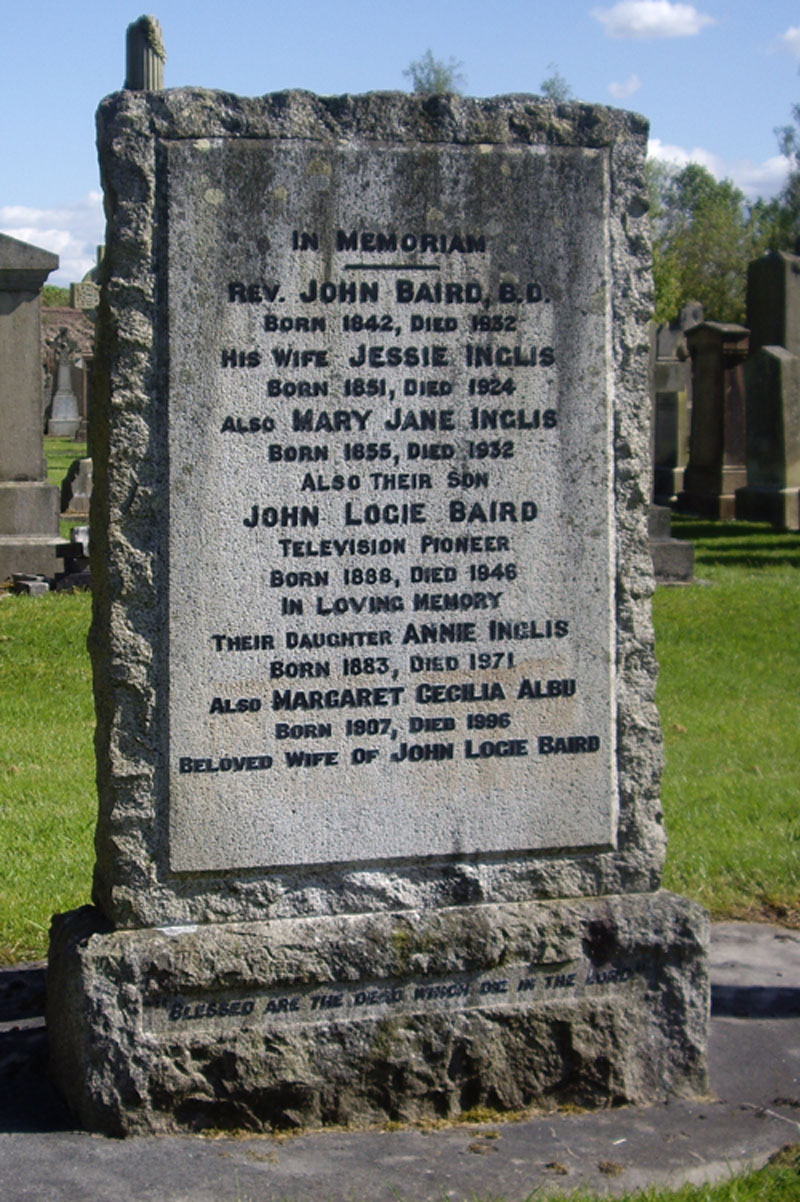
Taken from: https://en.wikipedia.org/wiki/John_Logie_Baird [02.10.2013]

No comments:
Post a Comment